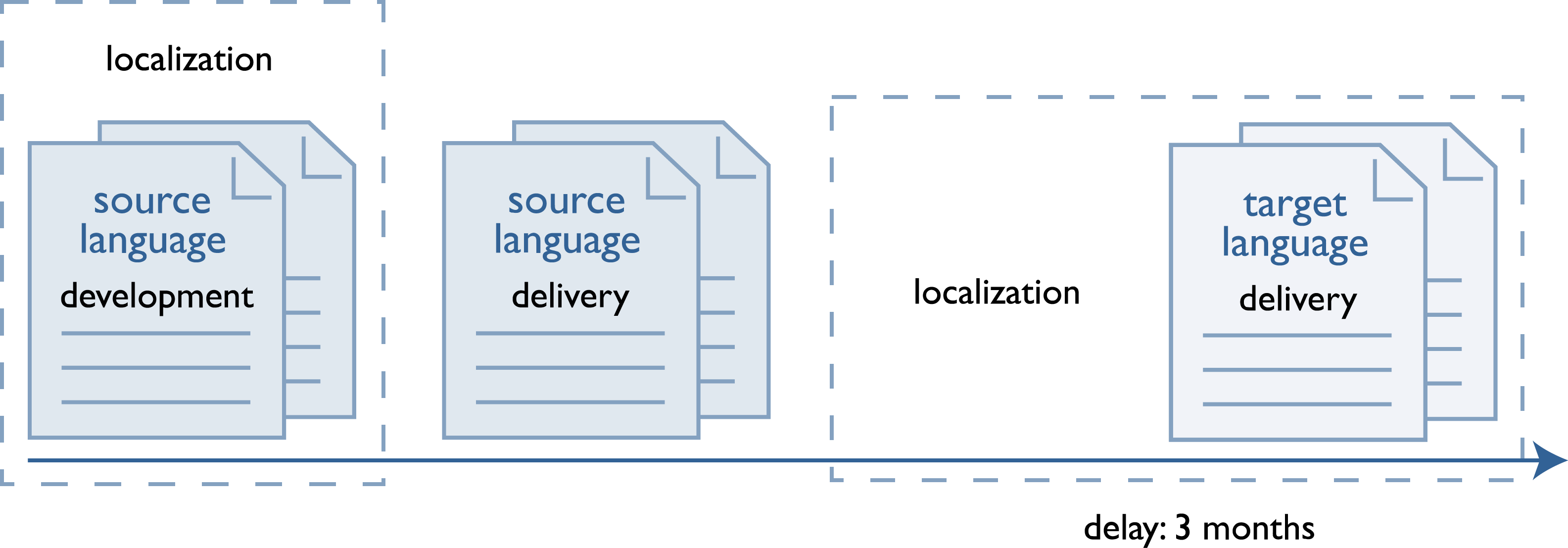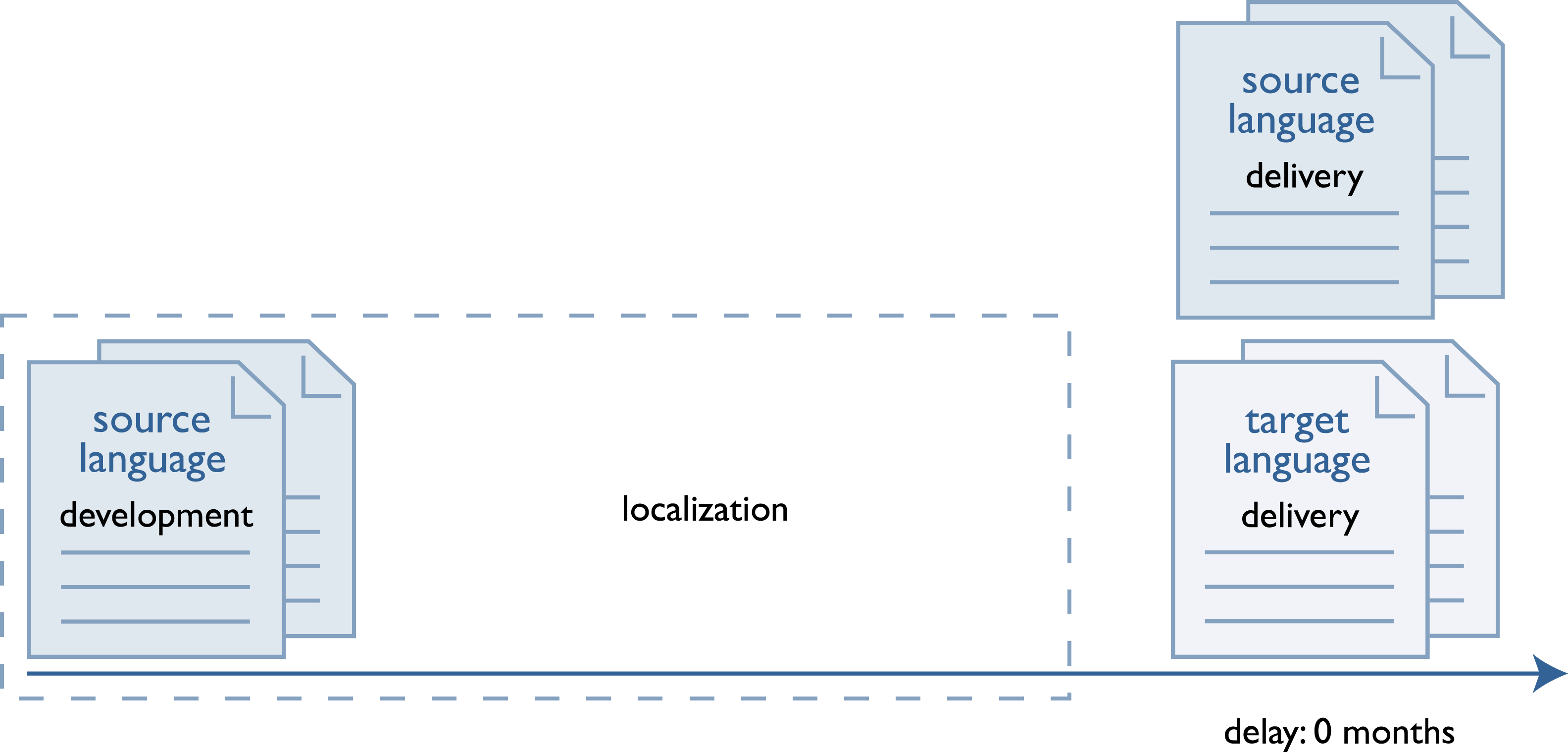Localization strategy: Your key to global markets
Coauthored by Bill Swallow and Gretyl Kinsey
The challenge of global markets
In 2015, S&P 500 companies sold 44% of their products outside the US.1 Without a global market strategy, companies are passing up nearly half their potential revenue.
But delivering products and services globally is no easy task. Professional translation is expensive and time-consuming. Given an average of 250 words per page and cost of translation at 21 cents per word, translating 1,000 pages of content into a single target language costs about $50,000.2 For the European Union alone, more than 20 languages may be needed, resulting in a total cost of $1M per 1,000 pages.
Faced with these costs, many organizations3 approach the problem reactively—focusing only on reducing the per-word cost and the amount of content to be translated. There are, however, additional factors that organizations must consider, including the following:
- How much of a revenue increase would result in bringing translated versions of a product to market three months sooner? Six months sooner? Concurrent with the “core” release?
- How favorably do your non-English-speaking4 customers currently view your organization? How might that change if they could receive the same quality offering within the same time frame as other customers? Would they be more likely to promote your brand? Might that increase sales in certain markets?
Consider these statistics from Common Sense Advisory, a research firm specializing in global market issues:
- 72.1% of consumers spend most or all of their time on websites in their own language.
- 72.4% of consumers said they would be more likely to buy a product with information in their own language.
- 56.2% of consumers said that the ability to obtain information in their own language is more important than price.5
Organizations need a strategic approach to content for global markets. Consumers seek experiences that are tailored to them. Not taking a strategic approach to global content alienates your target markets and diminishes your brand reputation.
Understanding language issues
Localization—commonly abbreviated as L10N—is the adaptation of content or a product for a specific audience based on their location and language. In a perfect world, localization ensures that all of your target audiences—regardless of preferred language or geographic location—receive the same level of quality that you invested in your source (native) language.
A content strategy uses information to advance business goals.6 Localization strategy extends content strategy by adapting content assets for multiple locales and languages.
Note: Localization does not always mean translating content into another language. In many cases, the locale requires content changes. For example, consider a document that describes employee benefits in a department store. The version written for the United States would need to be localized for a store in Canada, where benefits are different. In addition to the content changes, the company would also provide a French version for the Canadian market.
A localization strategy lets you plan ahead for global market demands while making content and product development more efficient. It can help accelerate time to market, grow and strengthen customer relationships7, and better manage your overall operating costs.
Time to market
The simplest approach to localization is to complete all work for the source language before beginning localization work. Most organizations getting started with localization use this sequential approach because the simplicity is appealing. The disadvantage to this approach is that localized content is not available when a product is launched. The organization must either choose to launch globally with English-only content (bad) or work through multiple regional product launches as localized content becomes available (also bad).
A more complex approach builds localization efforts into the core development effort. By localizing product and content components as they are completed, an organization can reduce the gap between initial launch and fully localized product availability.
For some organizations, product releases must include all localizations. Typically, these organizations sell products to global customers. For example, a client might order the same product for use in the United States, Brazil, Thailand, and China. That client expects delivery of the products in each market with appropriate localization at the same time.
In this scenario, your localization strategy must address all market requirements up front. Realistic scheduling is critical with this approach. Without proper planning, the delay in producing the different language versions may push releases beyond planned release dates, or beyond the window of opportunity you may have in certain markets.
Your localization strategy must take into account your organization’s requirements for time to market. The smaller the allowable delay, the more integrated your localization must be into the overall product development effort.
Customer engagement
Global consumer brands, such as Coca-Cola or Apple, want to build a close, personal connection with their customers. These organizations need a localization strategy that is custom-tailored to each target market to create products and content that resonate with customers. By contrast, in a regulated industry, localization strategy must ensure that the organization complies with all applicable requirements. A pharmaceutical company, for example, must conform to specific labeling requirements.
The level of customer engagement needed will affect the breadth and depth of your localization effort. You can choose to provide full translations in every market, adapt the amount of localization effort based on market share goals, limit localization to machine translation only8, or use a hybrid approach.
Localization ensures that your products and services are usable, understandable, and culturally appropriate.
Planning and design
Planning ahead for translation can reduce rework and catch potential issues before they become problems. A localization strategy not only informs how and when to perform the translation work, but how to structure the development of all source language material.
An automobile is a good example. The same model may be distributed to many different countries, but with some variations. Handling each configuration as the need arises is extremely costly (especially where re-engineering is necessary) and significantly delays time to market. Instead, automotive manufacturers plan ahead and develop interchangeable components based on market requirements. This approach eliminates the need for re-engineering and allows each automobile variant to be assembled efficiently.
Supporting multiple languages requires you to accommodate complex design requirements. For example:
- Text expansion and contraction. When you translate from one language to another, the resulting text can be longer or shorter than the source. Text expansion is especially problematic in tightly formatted tables and in graphics with text.
“In general, the more flexibly you can design your layout, the better. Allow text to reflow and avoid small fixed-width containers or tight squeezes where possible. Be especially careful about fitting text snugly into graphic designs. Separate presentation and content, so that font sizes, line heights, etc. can be easily adapted for translated text. You should also bear these ideas in mind when designing database field widths in character lengths. […] English and Chinese text is typically very compact, and text translated from these languages will typically be longer in the translation than the original – sometimes to an alarming degree.”9
- Text direction. English and many other languages flow from left to right, but Arabic and Hebrew flow from right to left. As a result, you need to adjust print and web design requirements.
- Fonts. Many languages require fonts that go beyond the Latin alphabet. A font that works well for English and German content may not include the Cyrillic alphabet needed for Russian. Chinese and Japanese fonts require thousands of glyphs.
Ignoring requirements such as these causes significant rework as issues are discovered during translation. For example, not planning for localizations on a product’s LCD screen may result in the inconvenient discovery that Thai characters cannot be supported.
Identifying these market requirements, ensuring that everyone involved is properly informed (from sales to marketing to development to support), and building localization best practices into the design phase of a project reduces the likelihood for rework.
Consistency
Part of your localization strategy should involve centralizing common resources as much as possible. Sharing knowledge, resources, and content among groups improves consistency in approach, messaging, and wording. For example, it is not necessary for different software groups to translate common text, such as “Save” and “New Project,” over and over again for each application.
Employing content reuse improves consistency even more, and significantly reduces your translation costs.10
Increased quality
A mature localization strategy can increase the quality of all language versions you produce. When departments collaborate with the same strategic approach and share information, everyone benefits from discoveries, and best practices become shared knowledge.
Building efficiencies into infrastructure eliminates the time and effort spent formatting and implementing translations, allowing teams to focus on more meaningful tasks.
Editorial and quality review cycles also become more effective. Localization requirements and expectations can be built into iterative testing during the development phase. This approach identifies and addresses potential issues early in the development cycle, reducing (expensive) last-minute changes.
Controlled translation costs
Identifying translation needs at the beginning of a project allows you to properly estimate the translation effort. Accommodating translation requirements, such as fonts and text expansion, means reducing the amount of manual rework required in the translation process.
In larger organizations, we recommend using translation tools internally to estimate the scope and cost of translation. One key to translation cost is the amount of content that was previously translated and captured in translation memory. Armed with this information, you can approach translation vendors as an informed customer.
Factors affecting localization
Many problems encountered during translation can be traced back to issues with source content and infrastructure. Your localization strategy should account for internal improvements to increase the efficiency and accuracy of your localization efforts.
Source content quality
The quality of source content directly affects the quality and cost of translations. High-quality source content is especially critical for producing accurate machine translations.
Making adjustments in the following areas can help improve the quality of source content:
- Accuracy. Use correct spelling and grammar, and verify that the source content is factually accurate prior to translation.
- Understandability. Avoid jargon, slang terms, idioms, metaphors, and phrases specific to a single locale, as they do not translate into other languages easily (or at all).
- Sentence length. Keep sentences short and simple. Long, complex sentences are difficult for machine translation software to parse.
- Sentence structure. Use the standard English sentence order of subject-verb-object wherever possible, and write in active voice.
- Consistency. Use consistent style and terminology.
Images with text
If you use text within images, save the source image format (such as a native Adobe Photoshop file) that contains the different layers that make up the image. The text layers in the source contain editable text, which can be extracted for translation. When the text is translated, save the translation as a new layer in the source image file.
When publishing the image, change the visibility of the text layers to show a single language version. The following figure shows how a Spanish version of the image is prepared.
Style guides
Adhering to a style guide makes the translation process more efficient and less costly. Style guides ensure consistency by establishing rules in the following areas:
- Spelling, grammar, and punctuation (for example, when to use the Oxford comma, or whether to use an em dash or semicolon)
- Content structure (for example, what sub-headings are required in each document, and in what order)
- Tone (for example, whether the content is formal or informal, or whether it engages the reader directly or indirectly)
- Terminology (for example, which of two similar terms to use)
- Translation preparation (for example, how files are collected and sent to translators, and what translation workflow to follow)
Managed terminology or glossary
Most content creators use a set of terminology that is relevant to their industry or organization to ensure consistency. A glossary is a list of terms that needs to be used consistently throughout an organization’s content, with definitions for the terms and rules for their usage. Managed terminology uses software to track and control the use of terms.
For more efficient translation, store terminology in a termbase—a repository or database that manages the approved terms in both the source and target languages. A termbase is searchable and includes rules about term usage. A terminology management tool can be used with translation memory to help ensure consistency in the translations.
Internal translation tools
Using translation tools internally can help predict translation costs and improve consistency in your content. They help identify variations in similar wording, which can be standardized before translation. Using previous translations in translation memory, they can also provide realistic estimates for the number of words requiring translation.
Translation tools rank your content for translation into several categories, called matches:
- In-context, exact (ICE) match: the exact same text and surrounding text exists in translation memory already. It does not require translation.
- 100% match: the exact same text exists, but surrounding text is different. It does not require translation but should be proofread.
- Fuzzy match: the text resembles text in translation memory but there are slight differences. It may require editing or partial translation.
- No match: the text is either unique or too different from what is in translation memory. It requires full translation.
Scoping your translation needs up front in this manner provides more accurate cost predictions. Your source content can be edited before translating to correct fuzzy matches, which will increase consistency and further reduce costs.
Intellectual property and translation memory
The source content you develop is your intellectual property. If you use an outside translation vendor, your contract must specify that the translations are also your intellectual property. Ownership of source/translated content by the client is standard practice for the translation industry. We do not recommend engaging with a translation vendor who does not immediately agree to this standard.
When you send a file for translation, the translator imports your file into their translation tool. The text is extracted and broken up into short segments (usually by sentences or phrases) for translation. The translated segments are then stored in a database for later use. This database of translated segments is the translation memory. Ownership of the translation memory—not just the finished translated files—is critical and should be spelled out in your contracts.
Owning your translation memory isn’t just about owning your intellectual property. It prevents lock-in with a specific translation vendor. You can change translation providers or hire additional ones at any time and still benefit from your previous translation work by allowing them to work within or contribute to your managed translation memory.
Change management
Implementing a localization strategy creates significant change in how people approach their work. You need a change management plan to:
- Outline clear business goals for process change. If a proposed tool or process does not support your organization’s end goals, it should not be part of the solution.
- Establish clear communication among all parties. Establish communication channels early and involve everyone, even those who are indirectly affected by the process changes. The organization’s business goals should be front and center as part of all change-related conversations.
- Hire a consultant, even part-time. Because consultants come from outside the organization, many employees give what they say more credence, even if the consultants end up repeating the very things you’ve been saying all along. A consultant can also act as the “bad cop” in unpleasant situations.
Summary
Localization strategy gives you a roadmap to thrive in a competitive global business environment. To build your localization strategy, you must assess each locale for regulatory constraints, industry expectations, language requirements, content delivery options, and more. A successful localization strategy aligns responsibilities across the organization—infrastructure, content sharing and collaboration, workflows, and more—to deliver products and services globally.
This post is also available in PDF format.
References
- PR Newswire, S&P 500 Foreign Sales at 44.3%, Lowest Level Since 2006, http://www.prnewswire.com/news-releases/sp-500-foreign-sales-at-443-lowest-level-since-2006-300304662.html, accessed May 11, 2017
- Slator, USD 0.21 per Word: America’s Translation Rate, https://slator.com/deal-wins/usd-0-21-per-word-americas-translation-rate/, accessed May 10, 2017
- In this document, the term organization refers to any entity that produces customer-facing content: for-profit and not-for-profit entities, businesses, associations, government agencies, and so on.
- This paper assumes English as the source language.
- Harvard Business Review, Speak to Global Customers in Their Own Language, https://hbr.org/2012/08/speak-to-global-customers-in-t, accessed May 10, 2017
- Content Strategy 101, http://contentstrategy101.com/, accessed May 9, 2017
- Entrepreneur, A World of Customers Is Waiting to Read Your Website in Their Language, https://www.entrepreneur.com/article/237082, accessed May 10, 2017
- Scriptorium, 2017 content strategy trend: the rise of the machine (translation), https://scriptorium.com/2017/01/2017-content-strategy-trend-rise-machine-translation/, accessed May 16, 2017
- W3C, Text size in translation, https://www.w3.org/International/articles/article-text-size, accessed May 15, 2017
- Scriptorium, Reduce translation costs with XML, https://scriptorium.com/2016/07/reduce-translation-costs-with-xml/, accessed May 17, 2017









Pradeep
Thanks for sharing